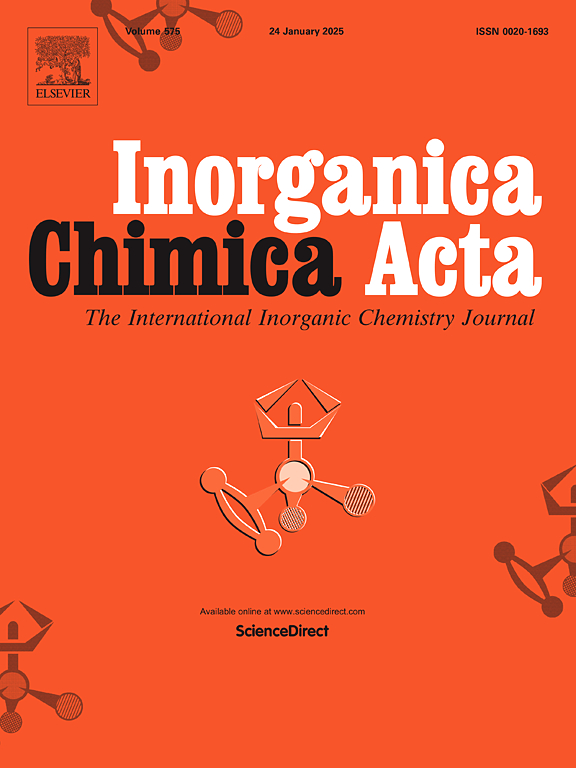铜配合物[Cu(L-Leu-L-Phe)]和[Cu(L-Phe-L-Leu)]的理化性质和抗癌活性
IF 3.2
3区 化学
Q2 CHEMISTRY, INORGANIC & NUCLEAR
引用次数: 0
摘要
为了研究二肽异构体(l - ph - l - leu和L-Leu-L-Phe)的序列对铜配合物理化性质和抗癌活性的影响,采用文献改进的方法制备了两个配合物[Cu(L-Leu-L-Phe)](1)和[Cu(l - ph - l - leu)](2)。通过单晶x射线衍射、热重分析和红外光谱对配合物进行了表征。评估包括旋光度、紫外可见光谱和对人食管癌细胞系Ec9706的抗增殖活性。两种配合物具有相似的紫外可见光谱和热稳定性,但比旋光度不同(1:862.3;2:476.3)。在抗癌试验中,配合物1 (IC₅₀= = 45.7,95% CI 37.2-55.9 μM)对Ec9706细胞的活性比配合物2 (IC₅₀= 71.4,95% CI 66.8-76.8 μM)更强,两者都显示出抗增殖作用。这些发现为开发肽类抗癌药物提供了基础。本文章由计算机程序翻译,如有差异,请以英文原文为准。
![Physicochemical properties and anticancer activity of copper complexes [Cu(L-Leu-L-Phe)] and [Cu(L-Phe-L-Leu)]](https://img.booksci.cn/booksciimg/2025-9/106316909871791175509.jpg)
Physicochemical properties and anticancer activity of copper complexes [Cu(L-Leu-L-Phe)] and [Cu(L-Phe-L-Leu)]
To investigate how the sequence of dipeptide isomers (L-Phe-L-Leu and L-Leu-L-Phe) influences the physicochemical properties and anticancer activity of their copper complexes, two complexes [Cu(L-Leu-L-Phe)] (1) and [Cu(L-Phe-L-Leu)] (2) were prepared using a method modified from literatures. The complexes were characterized via single-crystal X-ray diffraction, thermogravimetric analysis, and IR spectroscopy. Assessments included optical rotation, UV–Vis spectra, and antiproliferative activity against the human esophageal carcinoma cell line Ec9706. Both complexes exhibit similar UV–Vis spectra and thermal stability but differ in specific optical rotation (1: 862.3; 2: 476.3). In anticancer assays, complex 1 (IC₅₀ = = 45.7, 95 % CI 37.2–55.9 μM) showed stronger activity against Ec9706 cells than complex 2 (IC₅₀ = 71.4, 95 % CI 66.8–76.8 μM), with both showing an antiproliferative effect. These findings provide a basis for developing peptide-based anticancer agents.
求助全文
通过发布文献求助,成功后即可免费获取论文全文。
去求助
来源期刊

Inorganica Chimica Acta
化学-无机化学与核化学
CiteScore
6.00
自引率
3.60%
发文量
440
审稿时长
35 days
期刊介绍:
Inorganica Chimica Acta is an established international forum for all aspects of advanced Inorganic Chemistry. Original papers of high scientific level and interest are published in the form of Articles and Reviews.
Topics covered include:
• chemistry of the main group elements and the d- and f-block metals, including the synthesis, characterization and reactivity of coordination, organometallic, biomimetic, supramolecular coordination compounds, including associated computational studies;
• synthesis, physico-chemical properties, applications of molecule-based nano-scaled clusters and nanomaterials designed using the principles of coordination chemistry, as well as coordination polymers (CPs), metal-organic frameworks (MOFs), metal-organic polyhedra (MPOs);
• reaction mechanisms and physico-chemical investigations computational studies of metalloenzymes and their models;
• applications of inorganic compounds, metallodrugs and molecule-based materials.
Papers composed primarily of structural reports will typically not be considered for publication.
 求助内容:
求助内容: 应助结果提醒方式:
应助结果提醒方式:


